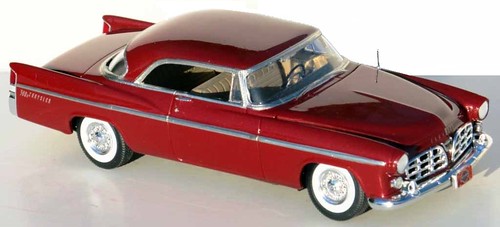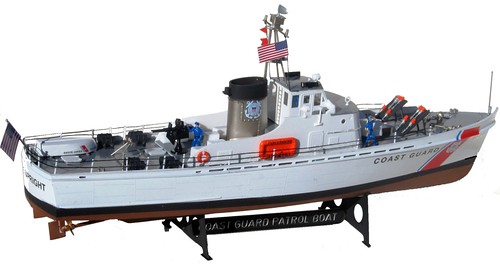Right On Replicas, LLC Step-by-Step Review 20150105*
1956 Chrysler 300B 1:25 Scale Moebius Model Kit #1207 Review

Review and Photos by Alan Mann 
The Chrysler 300 “letter series” were limited production, high-performance luxury cars built by Chrysler from 1955–1965. Each year’s model used a new letter of the alphabet as a suffix, except for “I”, reaching 300L by 1965, after which the model was dropped. The 300 “letter series” cars were among the performance based vehicles built by U.S. manufacturers after World War II, and thus can be considered one of the earlier muscle cars, though much more expensive and exclusive. The ‘56 300B was fairly similar externally to the ‘55, distinguished only by a new tailfin treatment. Two new engine models of the 354 ci (5.8 L) Hemi V8 with either 340 or 355 hp were available. Performance was a little better than the previous year’s, being measured at almost 140 mph.  New interior options included a Highway Hi-Fi phonograph player. Only 1,102 of the 1956 300B’s were sold.
Â
For the Modeler: This review covers the Moebius Models Chrysler 300B from 1956. This is a Skill Level 3 kit in 1/25 scale. Moebius recommends builders over 15 for this Skill Level. The kit is molded in Gray, Chrome, Clear and Clear Red with Pre-Printed Whitewall tires. There are 12 sprue trees with over 130 highly detailed parts. The motor assembles into a very detailed Hemi. The chassis is multiple  parts and again has a lot of details. The interior is a multiple part tub with the dash details as decals. The body is crisply molded with only minor mold lines on the C-pillars. There is a decal sheet included with necessary scripts. The instructions are VERY DIFFERENT than the usual US kit on the market today. The Instructions are a Tri-fold 8.5â€X11†with one side in full color! The front page is the box art in color with prerequisite warnings. The interior part has the construction sequences in a blue tint with written step by step build instructions. One full page shows built up areas that include the interior, engine compartment, chassis underside, dashboard, engine out of the car and a front and rear three quarter view. These are also used to place the decals. On the back of the instructions is a table that shows what parts of the car are painted what color. All of them are referenced to Testors paint by name. For the exterior colors it does reference Testors paints, but recommends buying more closely matching lacquers from an aftermarket paint company. Overall built dimensions are: Length: 8-3/4â€, Width: 3â€, Height: 2-3/4â€.
parts and again has a lot of details. The interior is a multiple part tub with the dash details as decals. The body is crisply molded with only minor mold lines on the C-pillars. There is a decal sheet included with necessary scripts. The instructions are VERY DIFFERENT than the usual US kit on the market today. The Instructions are a Tri-fold 8.5â€X11†with one side in full color! The front page is the box art in color with prerequisite warnings. The interior part has the construction sequences in a blue tint with written step by step build instructions. One full page shows built up areas that include the interior, engine compartment, chassis underside, dashboard, engine out of the car and a front and rear three quarter view. These are also used to place the decals. On the back of the instructions is a table that shows what parts of the car are painted what color. All of them are referenced to Testors paint by name. For the exterior colors it does reference Testors paints, but recommends buying more closely matching lacquers from an aftermarket paint company. Overall built dimensions are: Length: 8-3/4â€, Width: 3â€, Height: 2-3/4â€.
Â
Covered in this Review: If you want to perfect your build; basic construction; preparing parts for better finishing; alternate assembly sequence suggestions for fit and ease of finishing; complete paint and adhesive selections and applications; test fitting; complete engine construction and detailing; explaining instruction errors; making realistic tires; using white glue for glass parts; avoid damage with this body to chassis alignment method; dashboard detailing; gauge decal map; authentic interior color scheme; front and rear suspension build sequence; chassis installation; removing unwanted copyright script; making realistic tires; using “clear†glue for the windows; expanded kit history; making your own custom license plates and floor mats; carpeting to the interior pan; identifying and removing mold lines and ejector tabs; detailing the engine bay with gloss variations; hood hinge considerations; techniques for avoiding finish variations; suspension construction and detailing; using foil to create dazzling chrome trim; decal preparation and application; how to use decal setting solutions; aligning the steering box and exhaust; make 3-D looking springs; using floor polish to make perfect windows; are all fully examined in this extensive 20 page, full-color Step-by-Step review in PDF format.
Click the Buy Now link below to purchase the full Step-by-Step review for $2.95 USD.
Important – You MUST click on the “Return to Right on Replicas, LLC” link after you’ve made your purchase to download your review!
Right On Replicas, LLC ©2015 All rights reserved. *All registered trademarks are the property of their respective brands. Follow the manufacturer’s safety recommendations for any product mentioned here.





